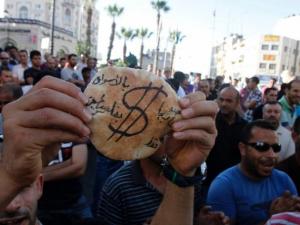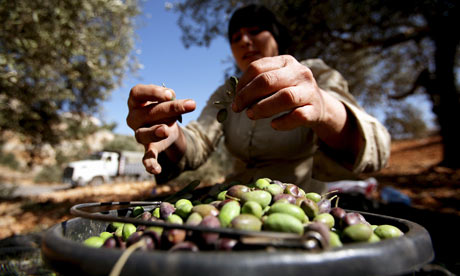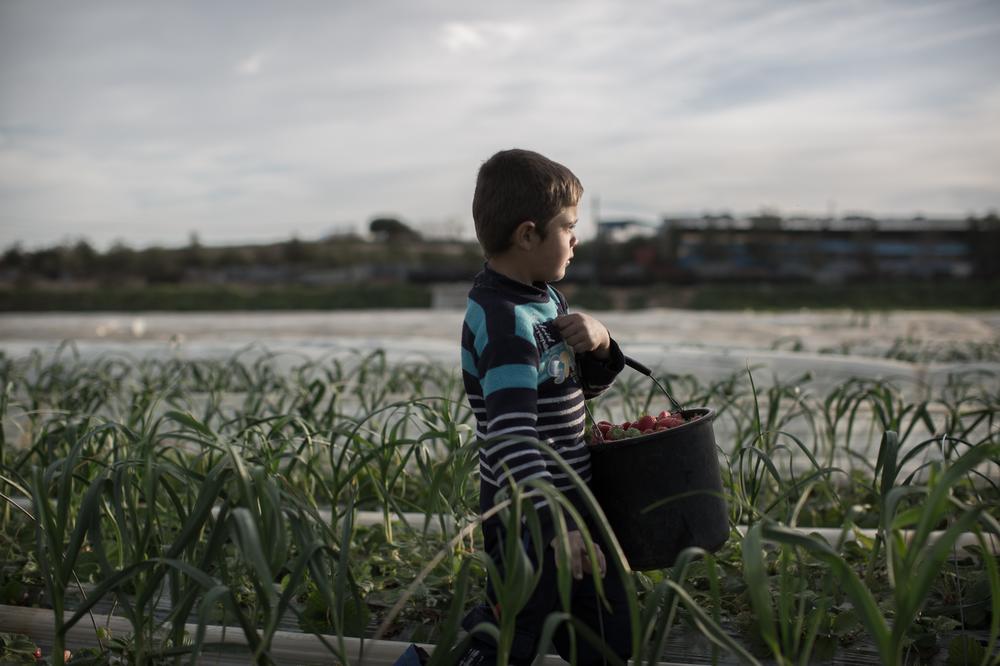
Palestinians in Ramallah protest high cost of living and the Paris Protocol regulating trade with Israel. (Maan News Agency)
Political Economy of Palestine
A recent Financial Times profile of a budding Palestinian brewery noted the difficulties the three Sayej brothers of Birzeit confronted when they attempted to launch Palestine’s second beer after the much- lauded Taybeh put Palestinian brews on the proverbial map. “The Palestinians do not control their own borders, and transport is expensive because of the logistical challenges involved in clearing Israeli checkpoints and moving goods through the Israeli port of Ashdod,” the Times pointed out. Moreover, the brothers “faced delays in setting up their bottling line” after Israel denied entry to two foreign technicians who were due to help with the new brewery. And, lastly, there was the trouble of importing malt from the Czech Republic: “Mr Sayej says he struggled to secure his first malt imports because Israeli distributors of the raw material wanted to sell it to him themselves.” In the end, the brothers were able to commence production, but their experience illustrates the structural hurdles and arbitrary nature of Israeli restrictions that Palestinian entrepreneurs must contend with as a result of the occupation. It is also a very clear demonstration of the inextricability of the economic and political challenges before the Palestinians, which collapse into the same channel either to advance or retard progress.
Surprisingly, however, much of the literature published by donor-countries and international organizations providing aid to the Palestinian Authority (PA) separate Palestinian economic development from the political resolution of the Palestinian question. No serious observer would claim that the occupation is incidental to the Palestinian economy, but the conventional wisdom on Palestine is that material development is a step toward statehood rather than sovereignty being a precursor to sustained economic growth. This cart-before-the-horse approach isn’t confined to Western officials or Israel’s cynical spokespersons, but espoused by many PA officials.
Recall the excited chorus heralding the promised peace dividend for Palestinians after the signing of the 1993 Oslo Accords: Western donor aid, Middle East investment, and contributions from the Palestinian diaspora would pour into the West Bank and Gaza Strip and transform the territory of a would-be Palestinian state into the Singapore of the Middle East. This optimistic vision held that an ongoing peace process would unleash Palestinian potential even as the configuration of Israeli occupation remained largely intact if not permanent. The PA has no control over borders, air or sea ports; it cannot issue import/export licenses or host technical staff without Israeli permission; it is not responsible for the distribution of energy sources or water; and, last but not least, the PA-governed territory is neither contiguous nor does it constitute the geographic majority of the West Bank. Somehow, the architects of Oslo expected that the PA would usher in an economic miracle in isolated Palestinian cantons while stripped of any of the attributes of sovereignty or the foundations of statehood.
Not surprisingly, more than 20 years on, the Palestinian economy remains entirely dependent on Israel, just as it was prior to Oslo. If anything, the economic reality has worsened for Palestinians as the West Bank has been fractured into Areas A, B, and C, severing the organic link between Palestinian cities and villages (Area A under nominal PA rule, Area B under shared PA-Israel control, and the roughly 60% of the West Bank in Area C under full Israeli control). Furthermore, illegal Israeli settlements in the West Bank have dramatically increased since Oslo, leading to the loss of even more Palestinian agricultural land, especially in the fertile Jordan Valley. The situation in Gaza is even bleaker: Under an Israeli-Egyptian blockade since 2007 and after repeated Israeli attacks on the territory, Gaza’s GDP per capita is lower now than in 1993.
* * *
For our May Special Focus – Political Economy of Palestine, we present a series of our articles from the Journal of Palestine Studies that investigate and recount the trajectory of the Palestinian economy since Oslo. Together, these articles, inter alia, address the privatization of the occupation whereby Israeli middlemen act as arbiters between Israeli security forces and Palestinian economic elites, clearly illustrating where power and control lie; the PA’s deep embrace of neoliberalism, which has undermined the local private sector and given rise to the large economic disparities typical of such regimens; the ongoing failure of Palestinian trade unions to effectively uphold the interests of their members; and the emergence of a tunnel economy in Gaza in response to the blockade. Lastly, we include an article on the “Arab Economy” inside Israel. While Israel’s Palestinian citizens do not live under occupation, they face similar restrictions and the discriminatory allocation of resources, which have greatly curtailed development in Arab towns and villages. This last article reminds us that Palestinian well-being, and the meaningful self-determination necessary to pursue it, is a common struggle for Palestinians whether in Israel, the West Bank, or Gaza.
Journal of Palestine Studies:

Leila Farsakh
Journal of Palestine Studies, Vol. 45 No. 2 (Winter 2016), pp. 55-71
This article reflects on the body of knowledge that has been constructed around the Palestinian economy. It traces the paradigm shifts between the two most commonly used theoretical frameworks—neoliberalism and colonialism—and assesses their success in analyzing and explaining the determinants of Palestinian economic growth. The Zionist project itself as well as the significant disparities between the various Palestinian communities that exist (inside Israel, in the occupied territories, and in the diaspora) have figured unevenly or not at all in scholarly analyses. The paper argues that as a result, the scholarship on the Palestinian economy has been quite inconsistent. The discussion seeks to demonstrate that this inconsistency has compromised the ability of economists both to explain the failure of Palestinian development and to identify possible remedies.
Alaa, Aziz, and Haled Sayej, the founders of Birzeit brewery. (Financial Times)
 Gaza's Tunnel Phenomenon: The Unintended Dynamics of Israel's Siege
Gaza's Tunnel Phenomenon: The Unintended Dynamics of Israel's Siege
Nicolas Pelham
Journal of Palestine Studies, Vol. 41, No. 4 (Summer 2012), pp. 6-31
This article traces the extraordinary development of Gaza's tunnel phenomenon over the past decade in response to Israel's economic asphyxiation of the small coastal enclave. It focuses on the period since Hamas's 2007 takeover of the Strip, which saw the industry's transformation from a clandestine, makeshift operation into a major commercial enterprise, regulated, taxed, and bureaucratized. In addition to describing the particulars of the tunnel complex, the article explores its impact on Gaza's socioeconomic hierarchy, strategic orientation, and Islamist rule. The larger geopolitical context, especially with regard to Israel, the Sinai Peninsula, and the Nile Valley, is also discussed. The author argues that contrary to the intentions of its architects, the siege precipitated the reconfiguration of Gaza's economy and enabled its rulers to circumvent the worst effects of the blockade.
A smuggler carries American fast food KFC through an underground tunnel from Egypt to Gaza Strip, 13 May 2013. (AFP)
Raja Khalidi, Sobhi Samour
Journal of Palestine Studies, Vol. 40, No. 2 (Winter 2011), pp. 6-25
The Palestinian statehood-by-2011 program, framed through neoliberal institution building, redefines and diverts the Palestinian liberation struggle. Focusing on its economic aspects, and in particular the underlying neoliberal thought that goes beyond narrow economic policy applications, this essay argues that the program cannot succeed either as the midwife of independence or as a strategy for Palestinian economic development. Its weaknesses, the authors contend, derive not only from neoliberalism's inability to deliver sustainable and equitable economic growth worldwide, but also because neoliberal "governance" under occupation, however "good," cannot substitute for the broader struggle for national rights nor ensure the Palestinian right to development.
The city of Rawabi on the West Bank built by private Palestinian and foreign capital and marketed as the new model city for middle-class Palestinians. (Bayti Real Estate Investment Co.)
 Sixty Years after the UN Partition Resolution: What Future for the Arab Economy in Israel?
Sixty Years after the UN Partition Resolution: What Future for the Arab Economy in Israel?
Raja Khalidi
Journal of Palestine Studies, Vol. 37, No. 2 (Winter 2008), pp. 6-22
Despite the expectations of economic theory, a century of Arab-Jewish economic interaction in Palestine has not led to the convergence that is supposed to result from exchange between a capital-rich economy and a labor-intensive one. After 60 years of failed integration, the Arab population in Israel has fallen to the bottom of the socioeconomic ladder. With the Palestinian ““regional economies”” in Israel and the occupied territories operating as part of the same Israeli economic regime, the challenge for Palestinian economic policy makers is to build on the new paradigm in shaping a national development strategy aimed at reconstructing Arab-Jewish economic relations on the principles of balanced cooperation embodied in the Economic Annex of the 1947 UN partition resolution.
Palestinian woman gathers olives at an orchard in the West Bank. (Atef Safadi/EPA)
 The Palestinian Economy and the Second Intifada
The Palestinian Economy and the Second Intifada
Salem Ajluni
Journal of Palestine Studies, Vol. 32, No. 3 (Spring 2003), pp. 64-73
This report provides data on the cumulative effects on the Palestinian economy and society of Israeli restrictions imposed and damage inflicted during the al-Aqsa intifada through January 2003. The author argues that Israel is deliberately impoverishing the Palestinian population and that the United States, by failing to curb Israel, is complicit. The author also gives useful statistics showing what the Palestinian losses would be in U.S. terms.
A destroyed floor of Pioneer Foods factory in Gaza, eight months after an Israeli attack during the July-August 2014 war. (Sophia Jones)
 Privatizing the Occupation: The Political Economy of an Oslo Development Project
Privatizing the Occupation: The Political Economy of an Oslo Development Project
Peter Lagerquist
Journal of Palestine Studies, Vol. 32, No. 2 (Winter 2003), pp. 5-20
During Oslo, a Palestinian industrial estates scheme sponsored by international donors was marketed as a template for the occupied territories' integration into global markets. This article traces the project's significance as an encounter between donor agendas, development discourses, and the nexus of Israeli security prerogatives and Palestinian clientele politics that shaped Oslo's political economy. It argues that in addition to dubious economics, the scheme provided rent-seeking opportunities to Israeli middlemen arbitrating between Israeli security apparatuses and Palestinian economic elites, both rehearsing a wider tendency of development projects to obscure issues of power and control, and ultimately itself reinvesting a local, colonial genealogy of development as control.
Palestine Trade Tower in Ramallah, in the background, is the tallest building in the West Bank. (Tanya Habjouqa/Wall Street Journal)
 Palestinian Labor Flows to the Israeli Economy: A Finished Story?
Palestinian Labor Flows to the Israeli Economy: A Finished Story?
Leila Farsakh
Journal of Palestine Studies, Vol. 32, No. 1 (Autumn 2002), pp. 13-27
This article analyzes employment trends of West Bank and Gaza Palestinians working in Israel during the Oslo years (1993––2000). While significantly reduced from pre-1992 levels, Palestinian labor flows to Israel remained important but changed in form and content, revealing contrasting Israeli policies toward the two territories. In Gaza, labor links with Israel were increasingly severed, reflecting the growing separation of the two economies and the transformation of Gaza into a de facto labor reserve. In the West Bank, where the process of "Bantustanization" is described, workers continued to be employed beyond the Green Line and in the settlements, enhancing the incorporation of parts of the territory into Israel.
Palestinian workers on their way to Israel wait at the Qalqiliya checkpoint. (Nasser Ishtayeh/Associated Press)
 Palestinian Society and Economy: The Continued Denial of Possibility
Palestinian Society and Economy: The Continued Denial of Possibility
Sara Roy
Journal of Palestine Studies, Vol. 30, No. 4 (Summer 2001), pp. 5-20
This article explores the economic, political, and social changes in the West Bank and Gaza that have occurred since the beginning of the Oslo process in 1993. It argues that Oslo enabled Israel to control the Palestinian territories through the Palestinian Authority with damaging results that built up into collective disillusionment and rage that finally exploded in the al-Aqsa intifada.
Al Manara Square in Ramallah is the busiest commerical center in the city. (Tanya Habjouqa/Wall Street Journal)
Nina Sovich
Journal of Palestine Studies, Vol. 29, No. 4 (Autumn, 2000), pp. 66-79
In 1994, the Palestinian labor movement, crippled by years of factionalism and Israeli oppression, expected that the arrival of the Palestinian Authority would enable it to reorient its priorities from national politics to workers' rights. This article examines the trajectory of the trade union movement since Oslo and particularly the reasons for its ongoing factionalism and failure to meet its objectives.
Palestinians protest high prices of basic goods and the Paris Protocol governing trade with Israel, September 2012. (Anne Paq/Active Stills)
 Globalization, the Palestinian Economy, and the "Peace Process"
Globalization, the Palestinian Economy, and the "Peace Process"
Adel Samara
Journal of Palestine Studies, Vol. 29, No. 2 (Winter, 2000), pp. 20-34
Notwithstanding the peace process, the areas of the West Bank and Gaza under the jurisdiction of the Palestinian Authority remain dominated by Israeli economic policies and are subordinated to the prescriptions of international financial institutions, such as the World Bank and the IMF, which played a central role in designing the PA economy. The article concludes that the PA's unquestioning adoption of neoliberal economic policies favoring foreign capital at the expense of local capital has further weakened the local private sector and resulted in a kind of "development" that does not serve the population.
A Palestinian boy picks Strawberries in Beit Lahiya in the northern Gaza Strip, March 2015. Israel recently banned the sale of Gaza strawberries in the West Bank after strawberry boxes from Gaza were found in Israeli markets. (Dylan Collins/Al Jazeera)
Books:

The Gaza Strip: The Political Economy of De-Development. (2016)
By Sara Roy
In the new expanded edition of The Gaza Strip: The Political Economy of De-development, Sara Roy takes her meticulous study of the political economy of the Gaza Strip since the Israeli occupation in 1967 through to the impact, one year after, of Israel’s massive summer 2014 assault known as Operation Protective Edge. In the final edition of Roy’s ground-breaking work, she argues that Gaza’s trajectory over the last 48 years has reconstructed the territory from one that had been economically integrated and deeply dependent upon Israel and strongly tied to the West Bank, to an isolated and disposable enclave cut off from the West Bank as well as Israel and subject to ongoing military attacks. She further shows that these destructive transformations are becoming institutionalized and permanent; shaping a future for the Gaza Strip that is undeniably grim.
Control Food, Control People: The Struggle for Food Security in Gaza. (2013)
By Rami Zurayk & Anne Gough
Control Food, Control People examines the relation between Israeli strategies of control over Palestinians and the fostering of food insecurity in the Gaza Strip. The authors begin by documenting the current state of food and food production in Gaza. They then develop an integrative theoretical framework to identify the food security determinants that are commonly overlooked in the conventional definition of food security. Using this framework, and relying on primary and secondary data, they analyze the Israeli occupation of Palestinian land and culture. The picture that emerges is that food insecurity is not a side effect of the occupation but rather a strategic goal pursued by all Israeli governments.
While most of these articles are only available for this month, you can have access to our entire archives if you Subscribe to the Journal of Palestine Studies!
Generous contributions from people like you make it possible for us to preserve Palestinian heritage and defend Palestinian rights. Make a tax-deductible donation today!

 Neoliberalism as Liberation: The Statehood Program and the Remaking of the Palestinian National Movement
Neoliberalism as Liberation: The Statehood Program and the Remaking of the Palestinian National Movement Palestinian Trade Unions
Palestinian Trade Unions
